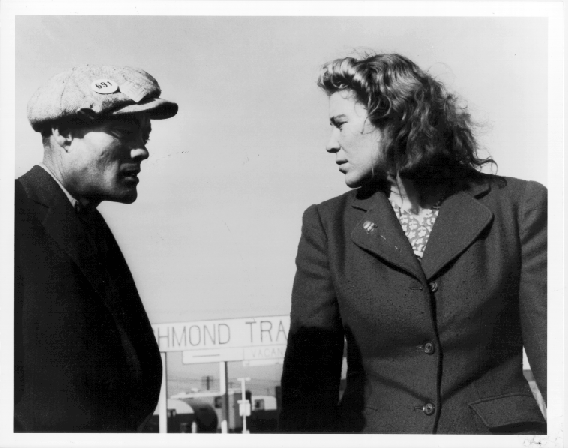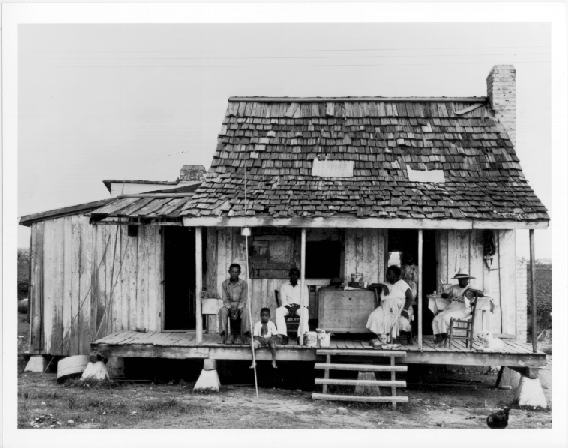

If Dorothea Lange was alive today, she would probably be out in United Nations Plaza, talking with and photographing the homeless. Shy as she was, Dorothea Lange was always interested in people: either her rich clients who sat for their portraits in her early career, or the migrant workers from Oklahoma she spent time with in later years.
Ask most people who know her work where and what she photographed and they will reply: bread lines, strikers, tenant farmers, the Central Valley, and the Great Plains.
Dorothea Lange is remembered for her images of proud and destitute share croppers from the south, and of the people who moved west in search of a brighter future who ended up in camps in the Central Valley.
Her portrait of a Migrant Mother, Nipoma, California, 1935 is a classic image of the dust bowl era. Several different versions of this famous image appear in the exhibit.
America was going through tremendous changes and Lange was there to document them. A explanatory placard at the exhibit states "By the 1930s, farm tenancy had essentially replaced slavery, making Black and White tenants equally vulnerable to landlord and reinforcing conditions of dependency and poverty. Here the causation of migration were manifest: the poverty of the overused and undernourished soil, the eagerness of farmers to produce mainly a 'cash crop' rather than living in harmony with what the land could produce and sustain, and finally the gradual introduction of large scale farming equipment, often financed by Roosevelt's various programs designed to help the poor farmer. Lange documented the change."
It is little wonder, that upon the outbreak of WW II, the population was on the move again. Much less know but of importance to our readers are the changes that Lange documented in Richmond. A recent article in East Bay Express failed to even mention Lange's Richmond photos.
The Lange show is divided up into several categories and several rooms: San Francisco and the Central Valley; Changes, Rural America; The War Years, and After the War. It is the War Years that most interested me. The room was filled with classic images of Richmond during the war.
The impact of displaced farmworkers moving to California that began in 1930s was followed by a mass migration of southern sharecroppers in the 40s to take the many wartime jobs that opened up in this bustling port city.
The Kaiser shipyards in Richmond built 727 ships during the war, including one-fifth of the country's Liberty Ships. The Anthony Wayne was completed in just four days. In Women Line Up for Paycheck Richmond Shipyard, 1942 happy workers are looking forward to relaxing after a hard day at work.
Due to housing shortages, people not only worked in shifts-they slept in shifts, too. Several images No Rooms; Camp, Richmond CA 1944; El Cerrito Auto Camp; Furnished Rooms, Richmond California, 1943; and Day Sleeper, Richmond, 1943 graphically display this problem. Many businesses were open 24 hours a day to cater to the defense workers. The pace was non-stop. In Cafe, MacDonald Street, Richmond, California, 1942, a young woman stands proudly in front of The Richmond Cafe, in her evening furs -- in the middle of the day.
The population of Richmond before the war was 20,000. After war broke out the Kaiser shipyard employed over 100,000 workers building freighters. The impact on the community was considerable.
Lange was fascinated by the human aspect of this change -- particularly by the ethnic and racial mix of people who worked along side each other [in Richmond]. Lange found the energy and newness of the experience exhilarating and saw in it a premonition of the future.
The images of Richmond in the Lange exhibit were taken for an assignment for Fortune Magazine. The article, written 1944, documented a 24-hour sequence at the Kaiser Shipyard in Richmond.
Dorothea Lange had a partner in this assignment -- Ansel Adams. Known for his monumental landscapes, especially of Yosemite National Park, they seem a mismatched pair. Even their styles of working were different.
Dorothea Lange was almost invisible as she wandered around photographing; Ansel Adams, however, wearing his ten-gallon and bushy beard, attracted attention. Crowds gathered around him as he set up his bulky photography equipment. In this assignment Dorothea Lange's people photographs were more successful than Ansel Adams'. (Adams will be the subject of a future article.)
You can see Lange's influence on Adams, though, in the photograph, Trailer Park Children, Richmond, California, 1944 in the companion show, Friends and Contemporaries - Documentary Photography in Northern California, where Adams captures a lyrical portrait of three children.
Life was not always that peaceful as shown in Relationship #2 Girl and Boy, Richmond California 1944 MacDonald Avenue. In Trailer Park Camp, Richmond, 1944, you can feel the tension between the unhappy couple.
Dorothea had a dream never realized of organizing a project modeled on the Farm Security Administration of the 1930s, to "study the ways society shift-change from a small rural community to an urban mass culture".
In addition to documenting the Richmond area, Lange also captured the changes occurring it the rest of the Bay area: Bill Board, Pleasanton CA, 1945, showing a large vacant field and a real estate Sign. The hills probably look the same today, but I'm sure the fields are gone. The growth in the suburbs after the war was phenomenal. The caption of another photograph says it all (Cafe Near Pinole, CA 1956):
"Rapid development of a previous rural area was occurring -- 'Dammit, it getting so a person can't stand still in one of these here fields without getting mowed down, raked up or painted'".
The rest of the exhibit covers Lange's later work, with optimistic photos about the first meeting of the United Nations held in San Francisco, after the war. She also worked on other series dealing with growth and change; traveling the country documenting the effects of Interstate highway construction on small towns and the effects of the construction of Lake Berryessa Valley on the residents.
The companion exhibit gives perspective on Lange's contemporaries, so be sure to see that, too.
Nothing compares to a black and white photograph for giving a feeling of veracity. In these days of colorized Casablancas', virtual reality and computer generated images, it is both refreshing and sobering to look at Dorothea Lange's work. Though the images are over 50 years ago, the themes are current.
Taking a last glance at the photograph of Argument... that appeared outside the Museum, I reflected on changes that Lange had documented, and on how much has remained the same.
(All photographs are courtesy of the Dorothea Lange Collection, The Oakland Museum.)
~~~~~~~~~~~~~~~~~~~~~~~~~~~~~~~~~~~~~~~~~~~~~~~~~~~~~~~~~~~~~~~~~~~~~~~~~~~
Reading List
------------
Henry J. Kaiser, Western Collosus: An Insider's View,
Heiner, Albert P., San Francisco: Halo Books, 1991
Dorothea Lange: A Photographer's Life,
Meltzer, Milton, New York: Farra Straus Giroux, 1978
Dorothea Lange: American Photographs,
San Francisco: SFMOMA and Chronicle Books, 1994
Richmond -- Windows to the Past,
Cole, Susan D., Richmond: Wildcat Books, 1980
-----------------------------------------------------------
FOR MORE INFORMATION VISIT...
San Francisco Museum of Modern Art
401 Van Ness Ave.
San Francisco, CA 94102-4852
(415) 352-4000
Hours: Mon.-Fri., 10-5; Sat. and Sun. 11-5
Call for admission Price
---Dorothea Lange: American Photographs, Friends and Contemporaries---
on now through September 4, 1994
The Oakland Museum
Oak and 10th Streets
Oakland CA
(510) 834-2413
Hours: Wed.-Sat., 10-5; Sun. 12-5
Call for admission prices
---Photographs by Dorothea Lange---
on permanent exhibit in the California Art Section
---Liberty Ships and Richmond---
in the History section
---Dorothea Lange Collection---
available by special arrangement only
Army Corp of Engineers Building, Bay Model
2100 Bridgeway
Sausalito, CA
(415) 332-3870
Hours: Tue.-Fri., 9-4; Sat. & Sun., 10-6
Admission Free
---Great Liberty Ship Exhibit on Marinship---
Richmond Museum of History
400 Nevin Avenue
Richmond, CA 94802
(510) 235-7387
Hours: Thurs., 12-4; Sat. & Sun., 11-4
Admission free
---Expensive exhibits on the history of the area including
information on the liberty ships and the Kaiser Shipyards
as well as books on local history---
Jeremy O'Brien LIberty Ship
Fort Mason
San Francisco
(415) 441-3101